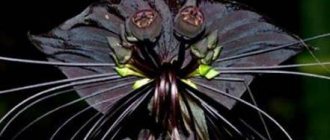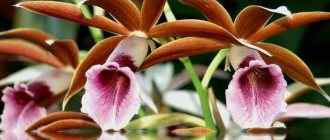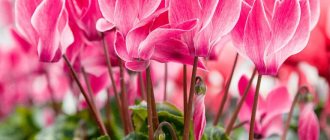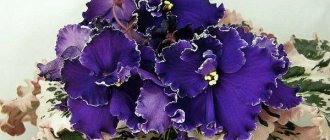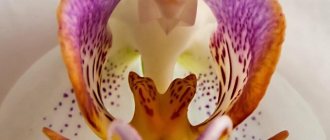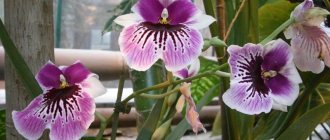There are many beautiful legends associated with orchids, one of which tells about a delicate plant with unusual flowers - the White Heron orchid.
On one of the Japanese islands, a shepherd was guarding goats; he was thinking about why someone is destined for an interesting, eventful life, while someone, like himself, is forced to just herd goats. He saw the answer in the meadow at his feet: an unusually beautiful flower grew on it, looking exactly like white herons flying in the sky. The shepherd realized that everything in the world is unimportant and passes quickly, and only beauty is eternal. He carefully dug up the flower and moved it to his garden.
Thus, according to legend, the White Heron has firmly entered the culture of Japanese gardens, where it is very popular and has been cultivated for not one or two hundred years.
Description and photo
The White Heron Orchid (lat. Habernaria radiata) belongs to the genus Habernaria and is found mainly in the following areas:
- Asia.
- Africa.
- South America.
- Far East of Russia.
A plant with a thin and straight stem, reaches a height of 20-30 (in rare cases 50) centimeters, which is classified as small or medium in size. The tubers are small, ellipsoidal or ovoid, 2-4 centimeters long. Each arrow usually gives rise to three or four flowers.
The leaves are juicy or light green in color, narrow oblong in shape, reaching 8 centimeters in length. The blooming flowers are a beautiful snow-white or pearl shade. The species is classified as protected.
Despite the fact that many Japanese families diligently grow it in their gardens, due to global climate change, the White Heron continues to become extinct.
LiveInternetLiveInternet
.Orchid of Japanese legend. Nowadays, more and more often in many floriculture magazines you can find photos and very few words about an orchid, whose flower resembles a flying bird. Habenaria radiata is its name. But what do we know about this stranger? Where and how does it grow, is it often found in nature and among orchid lovers, what is it? It was a long time ago, and far away... In a country on the edge of the earth, located on islands over which the Sun wakes up every day. On one of the islands, in a meadow, not far from the ocean, a little shepherd sat, he grazed special goats, the goats of Mikado himself, and sadly looked at the sky. And he was sad because he would never be able to become a samurai, this great warrior. And the little shepherd reasoned that life is not structured correctly, why some are born rich, and even if they don’t want to, they will become samurai. And others are born in poverty, they have to work a lot and hard, and even if they manage to save some money, they will never become a samurai. “Why this origin? Why do you need a title? Why aren’t everyone the same, even though they walk under the same sky, drink the same water, see the same birds?” — at this time he was distracted from his thoughts and saw a pair of flying white birds. They were herons, and they were so good that the boy forgot all his sadness. He sat and, without taking his eyes off, looked at the sky. And when the birds were no longer visible, the shepherd’s gaze dropped down to the grass... And then he noticed a white flower, miraculously similar to the beautiful white herons that had just soared in the sky. The shepherd boy carefully dug up a flower with thick strange roots with a stick and brought it home, where he planted it in an old bowl. And he took the bowl with the flower to a small garden near the house to admire the flower, so similar to soaring white herons. And the shepherd boy understood a very simple truth, which Buddha himself told him: “Everything in this world comes, like the flight of these birds, only beauty is eternal. Look at the flower and remember this!” Since then, the Japanese began to grow this orchid in their gardens. So says the legend, but what do we know about this orchid? Today, more than 600 species of the genus Habenaria are known, which grow in temperate and tropical climates. The largest concentrations of species of this genus are found in tropical South America, Asia and Africa. Habenaria radiata (synonym: Pecteilis radiata) is a terrestrial orchid widely distributed on the islands of Japan. It is often called the White Heron Orchid. The flower is beautiful and large, pearly white with a wide, heavy, fringed lip reminiscent of a white heron in flight. These are deciduous orchids that go into a dormant state after flowering. At the same time, the entire above-ground part of the plant dies off, leaving only a fleshy tuber-bulb. When the plant is dormant, resting, it needs a small amount of water, but as new growth begins, it is necessary to keep the plant moderately moist. Orchids of this genus are characterized by stems with leaves twisted into a spiral. At the top of a rather tall stem, a peduncle is formed. The peduncles of adult plants reach 40 cm and bear 1-10 flowers. The flower of this orchid has sepals and free petals fused into a lip. Deep-set lobed petals, with anther primordia outside the beak, which is connected to the column, with two outgoing stigmas and two anther canals, holding 2 soft dissected polynia. The flowering season lasts from mid to late summer, generally depending on planting time and weather conditions. Flowers last up to a month if pollination by insects does not occur. Each flower reaches a size of about 2.5 cm. This orchid is also found in our country in the Far East, in the south of Primorye, in damp meadows. Radiant guide - Habenaria radiata Spreng. A plant up to 20cm tall (perhaps our conditions are not ideal) with a spherical tuber at the end of a long stolon. Stems with 3-5 sessile broadly linear leaves up to 10 cm in length. Flower 1, rarely 2-3 pieces, up to 3 cm in diameter. Spur up to 4 cm long... Blooms in July-August. In Russia - located on the northern border of the range. Then the full range needs to be mentioned somewhere. The plant is found in a very limited area, but in some places it forms large clusters. We also have H.linearifolia (Line-leaved grasshopper) - in Primorye and Amur region; also with a spur, but the flower itself is more modest. In addition, there is also H. yezoensis, which grows in Japan, but here it is found only in Kunashir, in damp meadows. In Japan, Habenaria radiata is grown in pots, i.e. It is also cultivated indoors. The bulbs are planted to a depth of about 5 cm in an acidic soil mixture. Backlighting is required. This orchid has a reputation for being difficult to grow indoors. Perhaps this opinion has some basis. But here is a description of the experience of one gardener: “I finally managed to find a “common language” with this Japanese native after an unsuccessful attempt last year. I received 6 bulbs by mail, all 6 of them have grown, but only four of them are actively growing, the other 2 plants seem to be dormant, although they are still alive. After last year's failure, this year I used sphagnum moss and a ready-made soil mixture for ordinary indoor plants in equal parts for the substrate. To keep the substrate slightly moist and not dry out, cover the surface of the substrate with a layer of sphagnum. I preferred a shallow ceramic pot - approximately 5 cm deep. And already, on the tallest plant, approximately 30 cm, a flower bud-sheath appeared, directed upward, very similar to a thorn.” At one time, due to the general desire to have the orchid from the legend in their gardens, in Japan this orchid was endangered, as well as due to changes for the worse in its natural habitat. And has been listed as Vulnerable and Endangered (VU) by the Nature Reserve Conservation Committee in Japan (1989). And in order to maintain the genetic diversity that is lost during mericlonal propagation, they began to propagate the orchid by axenic seed germination. As a result of a long process from collecting seeds to obtaining tubers suitable for planting, flowering plants were obtained that were planted in nature. To grow Habenaria radiata in the garden, it is recommended to plant the bulbous tubers after the danger of spring frosts has passed. The bulbs are planted to a depth of 5-7 cm, in fertile, slightly acidic soil, the composition of which can be characterized as follows: ordinary garden soil and peat (50x50). The place is preferably bright or light shade is acceptable. In cold climates, mulching for wintering is recommended. This beautiful plant will be a wonderful decoration for any garden, and will look great indoors, in a pot, decorating our homes. I. Kozhevnikova.
Difference between the White Heron and other orchids
Among the huge variety of plants of this family, identifying this particular species will not be difficult :
- Habernaria radiata flowers are unique and resemble white flying birds,
- the orchid is quite picky and capricious in care, unlike many related plants,
- tuberous root system,
- during the dormant period, the above-ground part dies off completely,
- needs high humidity,
- the roots are completely immersed in the soil.
Maintenance and care
Orchids of the genus Habenaria radiata are rarely seen on windowsills; such flowers are quite capricious. Not every experienced gardener manages to grow this representative of orchids. In order for the standard to feel great, you need to create the necessary conditions for it :
- Cool temperatures , in summer the thermometer should not show more than 27 degrees;
- High humidity, at least 70%;
- The soil should not dry out , but there should not be excess moisture;
- An orchid of this type needs lighting.
Important! In winter, watering is reduced by half; a single moistening for two weeks is enough.
It is not recommended to replant the flower immediately after purchase , because most of these plants are purchased during the flowering period. It is recommended to replant after flowering before the dormant period.
It is recommended to apply fertilizer for the White Heron in a very diluted form ; it is best to use inorganic substances from specialized stores. Fertilize during the period of active growth once every two weeks. When the plant has expelled the peduncle, feed it a little less often.
Regular fertilizers will be the best stimulators of flowering . If the orchid blooms profusely and for a long time, then you are doing everything right.
Care after flowering consists of completely cutting off the above-ground part of the plant and giving it a period of rest .
of pests and diseases during the dormant period , the tubers are soaked in a solution of any fungicide for several minutes. Then the roots are well dried naturally.
Species of the genus Habernaria
There are several relatives of the White Heron.
Yezo guide – Habenaria yezoensis
It grows in Russia on the Kuril Islands , or rather exclusively in the swamps of Kunashir. Also grows in Japan. It has a straight stem and reaches 25-30 centimeters in height. The roots are tuberous, ellipsoidal in shape. In the lower part of the plant there are 6-7 linear-lanceolate leaves 4-6 millimeters wide and 6-11 centimeters long.
The inflorescences are up to ten centimeters in size and consist of 2-8 small flowers. One medium oval-shaped flower is surrounded by white unequal leaves. The ovary is twisted, with a short stalk. Flowering period is August.
Lineifolia grasshopper – Habenaria linearifolia
It grows in the marshy meadows of the Far East, feels comfortable near springs and in swamps . Also native to Japan, China, and the Korean Peninsula. The plant is tall - up to 70 centimeters; the tuber can have either a spherical or cylindrical shape.
There are few leaves, they are pressed to the stem, large, and grow linearly. The inflorescence consists of 8-15 small, up to one and a half centimeters in diameter, white flowers. The outer leaves are oval in shape, widening downward. The ovary is on a short stalk, twisted.
Psychedelic guide – Habernaria psycodes
The habitat is moist forests, swamps and grasslands of eastern North America . Can reach 90 centimeters in height. It has several significantly thickened roots. It has elliptical or wide oval, less often lanceolate leaves.
White flowers are rare; more often they are lilac in color. The lateral sepals are obtuse, oval, wider. The single upper sepal is narrow. Flowering period is from mid to late summer.
Guide jellyfish – Habenaria medusa
This endemic plant is found exclusively in Kalimantan, Sulawesi, Java and Sumatra. Because of its side petals, it is named after the Gorgon Medusa, a mythical creature with snakes on its head.
In its native lands, Jellyfish blooms during the hot and humid monsoons.
For the proper development of the plant, it is very important to maintain the seasonal growth cycle: the inflorescences and the entire above-ground part die off after 6-7 months, and a dormant period begins, during which the plant begins to store nutrients.
Habenaria Radiata
Sometimes nature amazes us with the splendor of its creations. In my opinion, she is especially good at flowers, among which orchids can be called one of the most beautiful. Some specimens were gifted by nature with such bizarre shapes that they fall into the soul at first sight, because they simply have no analogues. These include Habenaria Radiata, which has become popular recently.
Habenaria Radiata in our country is known as the Radiant Guide or the White Heron orchid. Its flowers are too reminiscent of soaring snow-white birds. But, her beauty served her poorly. Habenaria Radiata is extremely rare in nature. Thanks to its beauty, it was included in the list of endangered plants even in its homeland - Japan. Its habitat is swamps. But this did not stop admirers of beautiful flowers from barbarously exterminating this amazing flower. Therefore, it is extremely difficult to find it in nature. But it’s not so easy to buy Habenaria Radiata in the store. It is not very often that this flower appears on the counter. There is no question of meeting him in an ordinary flower shop. In order to become the owner of the Radiant Guide, you will have to try very hard.
It should be noted that the White Heron orchid is also found in Russia. You can find it in the Far East and Primorye.
Let's take a closer look at the description. The peduncle of Habenaria Radiata reaches a length of almost half a meter. There are about 10 flowers. It would seem that the flowers are of impressive size, judging by the photo. But that's not true. Only 2-3 cm! The leaves are narrow and long.
Bloom
Most often, the time of active flowering occurs in the period from mid to late summer (July - early September) and lasts about two weeks. When the orchid finishes blooming, the above-ground part of the plant dies off until the next season.
The peduncles are short, medium in size, the buds are small - about 5 centimeters in diameter. The lateral lobes are framed at the edges with fringe, the middle lobe is solid and straight. The flower is pure snow-white.
With direct contact, the plant is absolutely harmless, has no poisonous thorns or pungent odor.
Peculiarities
Habenaria White Heron has distinctive structural features , which determine whether the plant belongs to the genus:
- Root system in the form of tubers;
- Complete death of the ground part during dormancy;
- The horses are completely in the ground;
- Demanding on humidity.
Important ! After the flowering period, be sure to trim the above-ground part of the plant and allow it to rest.
The flowering period depends on when the tubers were planted or when they were taken out after a dormant period; most often, the time of “fluttering herons” occurs in mid-to-late summer.
White Heron usually blooms for about two weeks, but if insects do not fly up to the plant for pollination, the process is slightly delayed and can last up to a month.
The White Heron Orchid blooms once a season.
Repeated flowering in one season is rarely possible, even if it is stimulated with the help of special preparations. The plant must rest, even if the peduncle is expelled again, it should be cut off.
In case of repeated flowering, the plant may die due to excessive consumption of nutrients from the root system.
Purchase and cost
You can purchase this plant:
- from a private seller, according to an advertisement,
- on the websites of large breeders specializing in orchids,
- wholesale, from large holdings.
The price for Habernaria radiata starts from 1,500 thousand and depends on the place of purchase : since the orchid is difficult to grow at home, the price for a private advertisement will be higher.
You can also buy seeds and young plants on the websites of specialized stores. Seeds will cost approximately 400-600 rubles per 100 pieces, a teenager - 300-500 rubles per plant.
Reviews
Orchids of the genus Habenaria are not very common among flower growers , this is explained by the fact that the plant is quite capricious and fastidious in its care. But some were still able to tame and learn the tricks of growing this variety.
Elena, housewife. “In my house there are a wide variety of orchid species; the standard of the genus Habenaria, namely the White Heron, always attracts special attention. During flowering, you cannot pass by this plant; it is extremely beautiful.
I ordered the bulbs online; when they arrived, I seriously doubted their germination. In the spring I planted them strictly according to the instructions and by the end of summer the orchid delighted me and my family with its blooms. For the winter, I cut it off and hid it in a dark and dry place, but apparently I overdid it with watering, the tubers rotted.
A couple of months later, my husband brought me the same tubers from a business trip, and I was more careful with them. For several years in a row, the plant has been pleasing us with its annual flowering; for the summer I have adapted to planting the standard in the garden at the dacha.”
The White Heron Orchid is beautiful, but quite capricious and finicky to care for.
Alexandra Egorovna, pensioner. “Flowers have always meant a lot to me; all my life I have surrounded myself with this miracle of nature. After retirement, I had more time, so I started working on my dacha and indoor flowers more diligently.
The first orchids were given to me by my children, and then it went on and on... I traded with many friends, ordered plants by mail, and bought them in flower shops. At the moment I have a large number of indoor flowers of various types and families, but the orchids are the most exotic.
A favorite among them is the White Heron standard, which simply blows away everyone during flowering. The plant is quite fastidious in its care; before purchasing, I looked through a large amount of various literature to find out all the intricacies of care.”
Tatiana, owner of a flower greenhouse. “I have loved flowers since childhood, which is why my hobby has grown into my favorite job. White Heron brought the orchid with her own hands from China and purchased it from one of the well-known companies. Now we successfully cultivate this species in our latitudes and sell it in pots to other lovers of exotic plants. Each standard comes with short instructions on how to properly care for the flower at home.”
Reviews indicate that it is possible to grow an orchid of the genus Habenaria at home, the main thing is to strictly follow all care recommendations.
Landing
Choosing a pot
The White Heron loves cool weather and its roots should be completely covered with soil , so the pot should be wide, made of a material that does not conduct heat (stone, clay), 30-40 centimeters deep. You need to lay a layer of expanded clay on the stand and make sure it is wet.
The soil
To prepare a suitable substrate, pumice (small pieces), peat and sand are used; the ratio should be 1:1:0.5. A thin layer of sphagnum moss is laid on the surface. As another option, you can use a mixture of sand, moss, peat and perlite in equal proportions.
Planting process
- The tubers are soaked in water at room temperature for about fifteen minutes.
- Plant several at once in one pot. They should be recessed a little, about one and a half centimeters, with the pointed side down.
- The pot is placed on the window, with a southern, eastern or southeastern orientation.
Caring for Habenaria Radiata
Habenaria Radiata is highly not recommended for beginning gardeners. Caring for it requires scrupulousness and responsibility. When purchasing Habenaria Radiata, you will most likely receive a natural plant. Hybrid not adapted for home living. That is, you will have to recreate the natural conditions for its growth. As we remember, Habenaria Radiata prefers swamps. This means that we should organize a swamp in our home, no matter how funny it may sound.
Habenaria Radiata loves moist soil, but does not tolerate dampness at all. Therefore, we line the bottom of the pot with large expanded clay. The soil is a mixture of peat and sand. It is worth adding something to promote air circulation. Pumice stone, coconut chips, even polystyrene foam will do. Let the last layer be sphagnum. But not dry, as is customary among orchid breeders, but the most alive thing. Be careful. Don't overdo it with moss. Orchid lovers have probably already “experienced” how easily sphagnum moss causes rotting of the root system.
As for watering. Immersion in a basin of water for a couple of hours will do. Habenaria Radiata does not tolerate dry substrate at all. Therefore, it is very important to monitor the frequency of watering.
Landing
Tubers of Habenaria Radiata are planted in a pre-prepared substrate. Pointed tips up. There is no need for thorough immersion. Literally a couple of centimeters. The pot is placed in a warm, humid, sunny place. Several plants feel great in one pot, although it is worth considering that the pot must be large, due to the distance between the tubers.
Lighting
Like many orchids, Habenaria Radiata is light-loving, but does not tolerate scorching sun rays at all. In summer, it would be a good idea to place a pot of Habenaria Radiata outside or on an open balcony in order to recreate the natural temperature difference.
Rest period
Habenaria Radiata hibernates in winter. The death of the stem occurs around November. The plant dries out. Anything dry needs to be removed. Store the remaining tubers all winter in barely moist soil. In spring, the orchid should be transplanted into a new substrate.
Blooming Habenaria Radiata
Like the hybrid phalaenopsis, Habenaria Radiata is characterized by long flowering. About two to three weeks. In the middle zone, its flowering, as a rule, occurs at the end of summer.
Caring for a plant at home
- The orchid should be well lit from early morning.
- The soil should always be kept moist. The appearance of sprouts takes several weeks, after which watering is increased. You should use filtered water that has been standing for at least two days, ideally rainwater.
- Feed the plant with low concentration mineral fertilizers for orchids. Fertilizer frequency: once a month.
- The plant overwinters in a dark, cool room, with a temperature of about 8 degrees. In March it is returned to its place and watering begins.
- In the fall, the tubers need to be removed, dried and stored in a container with peat.
Diseases and pests
The plant is very susceptible to fungal diseases and pest attacks due to high soil moisture. The most common enemies of orchids :
- scale insect,
- whitefly,
- worm,
- gray rot.
The most effective methods of control are treatment with Actellik or Fitoverm, and it is also necessary to transplant the plant into a newly prepared substrate. Gray rot will die after treatment with any antifungal agent.
Reproduction
Orchids of the genus Habenaria have several methods of reproduction, which will be equally effective :
- The bush is divided after the end of the flowering period;
- Division by rhizomes is carried out in the same period or in early spring, but flowering from the trunks should not be expected this season;
- After wintering, the plant is propagated by tubers that formed last summer; they are simply cut off and planted in a new pot;
- You can propagate by bulbs: if there are several shoots on one, then the plant can be safely cut into pieces;
- The longest is propagation by seeds , the process is very difficult and lengthy. Luck depends on the moss; it is in reaction with specific microflora that the collected seeds can sprout.
Prevention of various problems
Treating the plant (its above-ground part) with a weak solution of phytoverm and regularly wiping the leaves on a preventive basis will avoid any troubles.
We can say that the White Heron is an incredibly beautiful, delicate and mysterious plant that occupies a special place in Asian, and especially in Japanese, gardening culture. The orchid is whimsical and an inexperienced gardener may not be able to grow it the first time. But the white flowers that look like beautiful birds are worth the time and effort. They will please the eye on warm summer days and remind you of the value of beauty.
External characteristics
It is easy to recognize the White Heron orchid among other representatives of this genus; its distinctive features are as follows :
- An adult plant during the flowering period is quite large in size ; together with the peduncle, it can reach half a meter;
- The number of leaves may vary , it all depends on the conditions in which the plant is kept. Most often, during the growth period, at least eight leaves, arranged alternately, grow and actively develop from the tuber;
- The peduncle of the trunk is unbranched, its height can reach 40 cm. Each arrow most often produces one, less often 3-4, flowers;
- Orchid flowers of this species are shaped like a flying White Heron , the diameter of each of them can reach 6 cm. This shape is formed due to a fringed lip that is almost completely fused. The pearly white color of the flower is very similar to the color of white herons that live in swamps. This is where our beautiful orchid lives in natural conditions.
